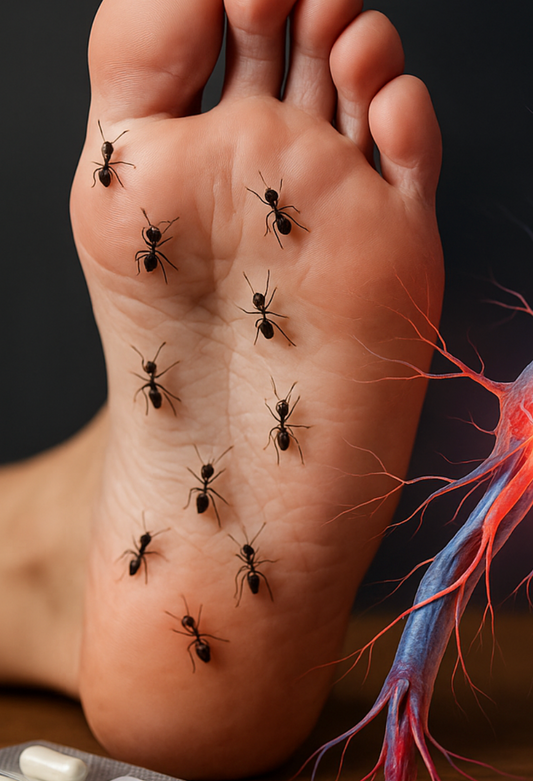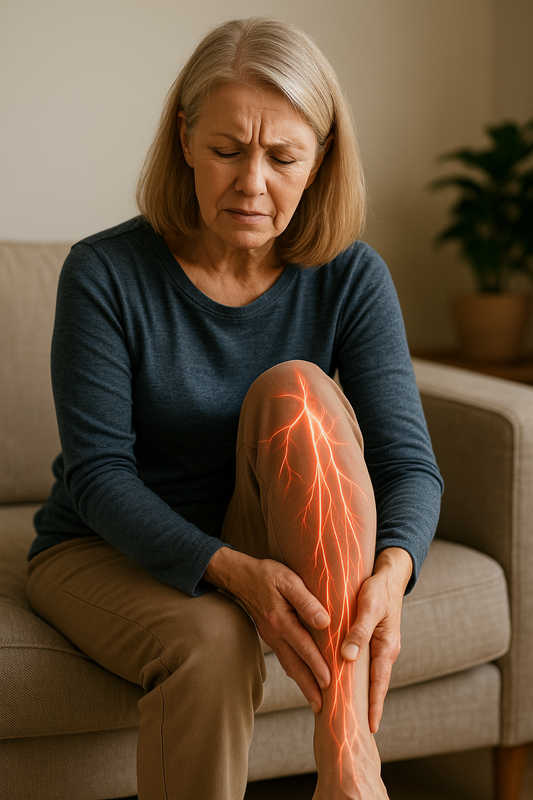How the right sleeping environment can relieve discomfort
You may have already heard of the well-known sleep hygiene rules: the bedroom should be dark, quiet and rather cool. But why could this help with certain complaints, such as nerve pain, exhaustion or other chronic ailments? In this detailed article, we get to the bottom of the concept of "dark and cold". We look at how an optimal sleeping environment influences the body and nervous system, what current studies say about it and how you can improve your sleep quality with simple strategies - even if you are struggling with chronic complaints that keep you awake at night.
Why sleep is so important for regeneration
Everyone spends about a third of their life sleeping. However, this time is not a luxury, but an essential part of our biological existence. While we sleep, the body carries out extensive regeneration and repair processes. The brain cleans up, sorts out experiences and consolidates what has been learned, the muscles relax and the immune system can fight harmful intruders. From a neurological point of view, sleep is particularly important because nerve cells (neurons) and glial cells can regenerate during this phase and new synaptic connections can form.
When you sleep well, your entire nervous system benefits from comprehensive rest. However, chronic conditions such as pain syndromes, exhaustion or nerve damage can mean that you do not sleep as deeply, wake up more often or cannot fall asleep properly at all. An unfavorable sleeping environment - too much light, too much noise or the wrong temperature - exacerbates the problem. This is where the "dark and cold" concept comes in: It is intended to support the biological conditions for restful sleep by adapting to your natural rhythms.
Light, darkness and the hormone melatonin
A key player in the relationship between darkness and sleep is the hormone melatonin. It is produced in the pineal gland of the brain and regulates your circadian rhythm. As soon as it gets dark outside, melatonin secretion increases, signaling to your body that it is time to sleep. Bright light - especially blue light from screens - inhibits melatonin production, which makes you awake or restless. Studies in the Journal of Pineal Research (2017) suggest that melatonin levels disrupted by artificial light can be linked to sleep problems, mood deterioration and even immune disorders.
The body reacts very sensitively to lighting conditions. Even a dimly lit night light or street lamps shining through the window can be enough to dampen melatonin production and fragment your sleep. People who also suffer from pain syndromes or nerve diseases are often particularly sensitive. A study in Pain Management Nursing (2019) concluded that patients with chronic pain slept significantly better and felt less exhausted during the day if they consistently darkened their bedroom and avoided screen use in the evening.
The Effect of Temperature on Sleep and the Nervous System
In addition to darkness, the temperature in the room also plays a crucial role. The body lowers its core temperature slightly during the night in order to optimally transition into the different phases of sleep. If your bedroom is too warm, this physiological process comes to a halt. You can then feel as if you are sleeping "superficially" and wake up more quickly. A study in Sleep Medicine Reviews (2018) confirmed that many people find temperatures between 16 and 18 degrees Celsius to be ideal for entering deep sleep.
But to what extent can a cool environment relieve symptoms? In cases of nerve damage or chronic pain, it is often reported that a slight coolness - combined with warm covers - is perceived as relieving. Apparently, the temperature gradient helps to stimulate blood circulation and metabolism without overheating the body. Some pain patients or people with restless legs syndrome (RLS) also use targeted ice packs or cool foot baths before going to bed to soothe their legs. Although the exact mechanisms have not been conclusively researched, initial studies in the European Journal of Pain (2019) indicate that cool temperatures can partially shut down the nervous system and thus dampen the sensation of pain.
Why “dark and cold” can be particularly helpful for nerve damage
-
Reduced flood of stimuli : Anyone who suffers from an overstimulated nervous system - for example due to polyneuropathy, fibromyalgia or chronic pain - benefits from as few disruptive stimuli as possible. Light that flickers through windows or device LEDs at night can further stimulate the nervous system subliminally. A cool room also prevents the feeling of overheating, which many patients find stressful.
-
More melatonin, fewer stress hormones : A darkened room promotes melatonin. By barely disturbing melatonin, you give your body the chance to find a deeper sleep. Deep sleep, in turn, means that you stay longer in regenerative phases in which pain processing and cell repairs take place. This can be very valuable for a strained nervous system.
-
Better sleep quality : Studies such as the one in the Clinical Journal of Pain (2018) suggest that people with chronic pain who pay attention to their sleep hygiene spend an average of 20-30 minutes less time awake and report significantly more restful sleep. Darkness and a cool room temperature (between 16 and 18 degrees) can be important components of this hygiene.
Concrete tips for a dark sleeping environment
- Blackout : Invest in blackout curtains or blinds to minimize the intrusion of street lights or car headlights. If that's not possible, a sleep mask can help keep the light out of your eyes.
- Minimize light sources : Look around your bedroom in the evening. Are there LEDs from TVs, chargers or other devices that are lit? If possible, unplug them or cover them up. Even a small standby light can subconsciously disturb your sleep.
- Blue light filter : If you have to use your smartphone or computer in the evening, activate a blue light filter or use glasses that filter out blue light. This will at least reduce the negative effect on melatonin somewhat. Nevertheless, it is best to significantly reduce screen time before going to bed.
How to cool your sleeping area
- Adjust the room temperature : A thermostat can help you keep the temperature constant. Sometimes it is enough to turn the heating down earlier and ventilate the room briefly before going to bed.
- Choose bedding : Use light, breathable duvets or materials (e.g. cotton, linen or special climate fibers). A duvet that is too thick can encourage sweating and cause you to wake up more often.
- Cool head, warm feet : Some people find it pleasant to keep their head cool but their feet warm. There is an old saying: "Cold feet rob you of sleep." This can be true if your feet cool down quickly anyway due to poor circulation. A foot warmer or cozy socks can help without having to heat up the room.
Study situation: sleep quality and pain management
There are several studies that link sleep environment and pain management. A meta-analysis in the Journal of Pain Research (2020) examined various factors of sleep hygiene in patients with chronic back and nerve pain. The result: darkness and a temperature in the cooler range (16-18 degrees) correlated with lower pain intensity the following day. The authors suspected that deeper sleep raises the pain threshold by promoting regeneration processes in the nervous system.
In another study in Sleep Health (2019), subjects with neuropathic pain were asked to create a strictly darkened and cooler sleeping environment for four weeks. Compared to a control group (no changes to the sleeping environment), the participants showed significant improvements in the time it took to fall asleep and sleep continuity. They also reported less daytime sleepiness and slightly reduced pain levels - not a miracle cure, but a noticeable relief.
What if you're too cold?
Not everyone likes sleeping in a room below 18 degrees. Some people get cold quickly or have a low body temperature. This requires a fine balance. You should never feel uncomfortable, because constantly being cold can disrupt sleep just as much as sweating. It is important that you allow your body to cool down a little without getting into extreme cold.
- Hands and feet : If you have sensitive, easily cold feet, try thin socks or an extra towel for the foot region. This will keep the peripheral extremities warm while your core stays cool.
- Hot water bottle : A small hot water bottle that you put on your feet before you go to sleep can help without heating up the whole room. Remove it again as soon as you are comfortably warm.
- Layering principle : Instead of a single thick blanket, layer two thinner blankets. Then you have the option of taking one off if you get too warm.
Additional measures for good sleep
- Relaxation techniques : Rituals such as a warm bath or a foot massage before bed relax the body and mind. Some people swear by essential oils (e.g. lavender) that provide a certain sense of calm.
- Small evening meals : A heavy meal just before bedtime can put pressure on the stomach and cause heat. Instead, it is recommended not to eat too much 2-3 hours before bedtime. Light, protein-rich snacks are possible, such as a small piece of cottage cheese or natural yogurt.
- Night modes on devices : If you do something on your phone or tablet in the evening, set screens to night mode or blue light filter so as not to inhibit the release of melatonin too much. It is of course better to minimize the use of digital devices before going to bed.
Conclusion
A cool, dark sleeping environment can be particularly helpful for chronic complaints and nerve pain by enabling the body to relax optimally. Darkness promotes the sleep hormone melatonin and reduces stress hormones, while a pleasantly low room temperature improves sleep architecture and prevents excessive sweating or restless sleep. Various studies, such as in the Journal of Pain Research (2020) and Sleep Health (2019), suggest that people with chronic and neuropathic pain benefit from such sleep hygiene.
Of course, not every organism is the same; some need a little more warmth or react sensitively to the smallest temperature fluctuations. However, as a rule of thumb, a room temperature between 16 and 18 degrees is ideal for most sleepers, provided you cover yourself accordingly. This can be underlined by clearly reducing the light: blinds, curtains or sleep masks filter out disturbing light sources so that your body can receive the signals: "It's night, time for regeneration." Try it yourself if you suffer from bad nights or pain: small adjustments to the room climate and light can sometimes have a big impact and provide you with noticeable relief.















